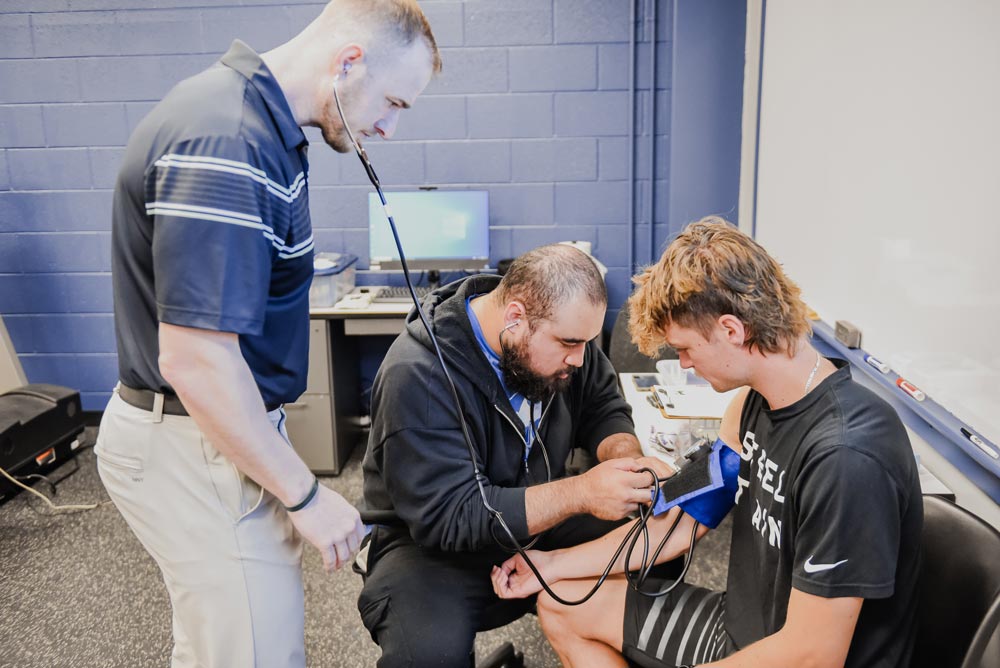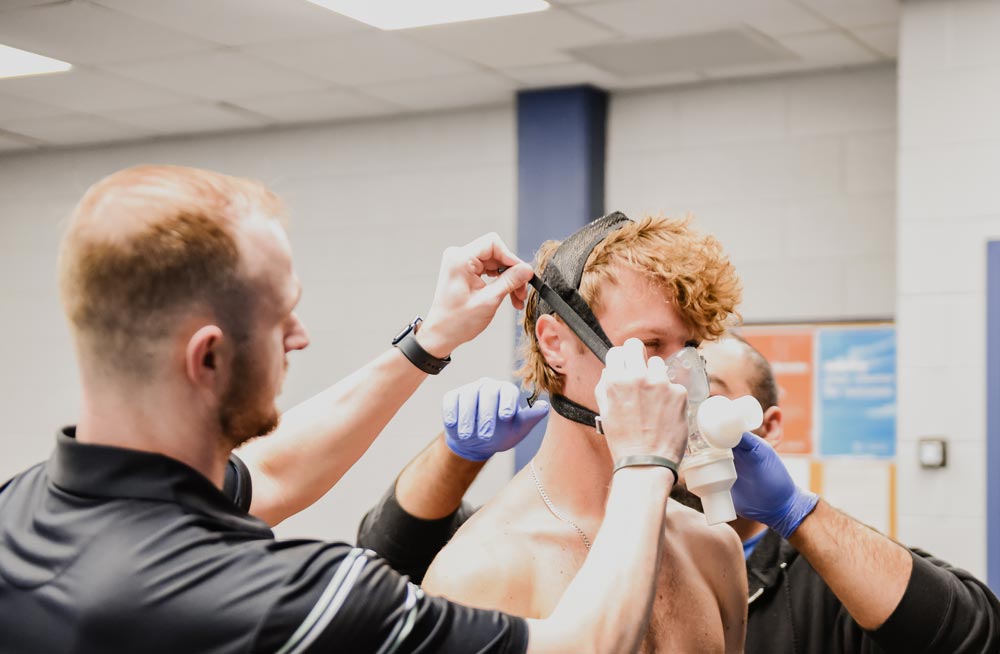As an Exercise Science major, Garrison Beach aims to help athletes be their best. A former football player at Midland University, Beach got a first-hand look at ways athletes can improve their performance through metabolic testing.


Metabolic testing evaluates how athletes use oxygen during exercise and places a metric on their fitness level. “It gives us a value we can compare for positional groups within teams and athletes across many sports,” said Nick Dinan, Dean for the School of Health Sciences. “Based on their fitness level, we can use that information to see different thresholds they hit during that test, and we can make a specific conditioning program based on their heart rate or metabolic numbers obtained during the test.”
Test participants are placed on a treadmill, and a mask is placed over their nose and mouth, along with a tube that is connected to a machine that will measure the amount of oxygen they consume throughout their workout. Participants begin with a slow walk that is then ramped up one mile per hour every two minutes. Once they reach a max speed of around 8-10 mph, a 2% incline is part of the process to increase exercise intensity. Dinan said the test can take anywhere from eight to as much as 15 minutes, depending upon the participant’s fitness level. “Our goal is to take them to their conditioning (or aerobic fitness) level max,” Dinan said. “Once they have completed the test, we can make observations and give them immediate feedback based on the data.”
Beach recently completed one of the tests and was excited to learn his fitness level was at an elite level. “My max was 61, which is an excellent number for my age,” he said. “Seeing that was cool, and it shows me that my training keeps me in very good aerobic condition. If my test was lower, I would change my training and add more aerobic training to improve my VO2 max and my body’s ability to utilize oxygen while training. In the sport/exercise science realm, it’s a great test to measure aerobic capacity and design training programs to improve an athlete’s aerobic capacity for their sport or goals.”
Dinan said efforts to utilize metabolic training for students and athletes have ramped up over the past several years as multiple faculty members value it from a nutritional and exercise standpoint. “It’s a staple of our Exercise Physiology, Advanced Strength & Conditioning, and Fitness Testing and Prescription classes,” he said. “Our Exercise Science and Strength & Conditioning majors would be the two groups utilizing it the most. However, we’re also seeing students who might be going into physical or occupational therapy who want to know this aspect of health. Within our Fitness Testing and Prescription class, students are required to complete this testing as part of their final practical. They will bring in a client from outside the class and take them through the entire process, including completing an informed consent and medical history, setting up the mask and completing a calibration, implementing the test, recording data, and interpreting the test results.”
Dinan said students are introduced to metabolic testing during their sophomore year, mainly through demonstrations, and will begin utilizing the machine themselves as juniors and seniors.
Beach got his first experience with the testing process this spring. “How to set up the test, run a client through it, and interpret the data was an awesome experience,” he said. “One thing that stood out to me was that the test itself was not extremely long. I think people had a preconceived idea of the test being 45 minutes or more and running as hard as possible on the treadmill. The test simply measures your body’s capacity to intake and utilize oxygen while working at a high aerobic capacity.”
The testing is a concrete formula to test athletes and raise their training and skill level to help them perform at their best. “This takes the guesswork out of performance,” Dinan said. “If you hope a program works, you’re not doing it right. We should be able to predict, modify, and train athletes to become what they need to be. I love getting excited about all the changes and adaptations we can get from this testing.”
Metabolic testing is just one of many different tests Dinan and his team can conduct through the Health Performance Lab, and he’s hopeful there are even more possibilities down the road. “Through a grant we received, we hope this is just the tip of the iceberg for us,” he said. “Within our lab, we have equipment to help strength or endurance athletes and can engage across any athletic or health fields.”
This knowledge can be a springboard for students entering human performance and health science careers. “These are transferable skills, and being proficient in metabolic testing will give them a leg up,” Dinan said. “This is the best way for us to give students those hands-on skills necessary to succeed no matter what health-related field students decide to pursue.”